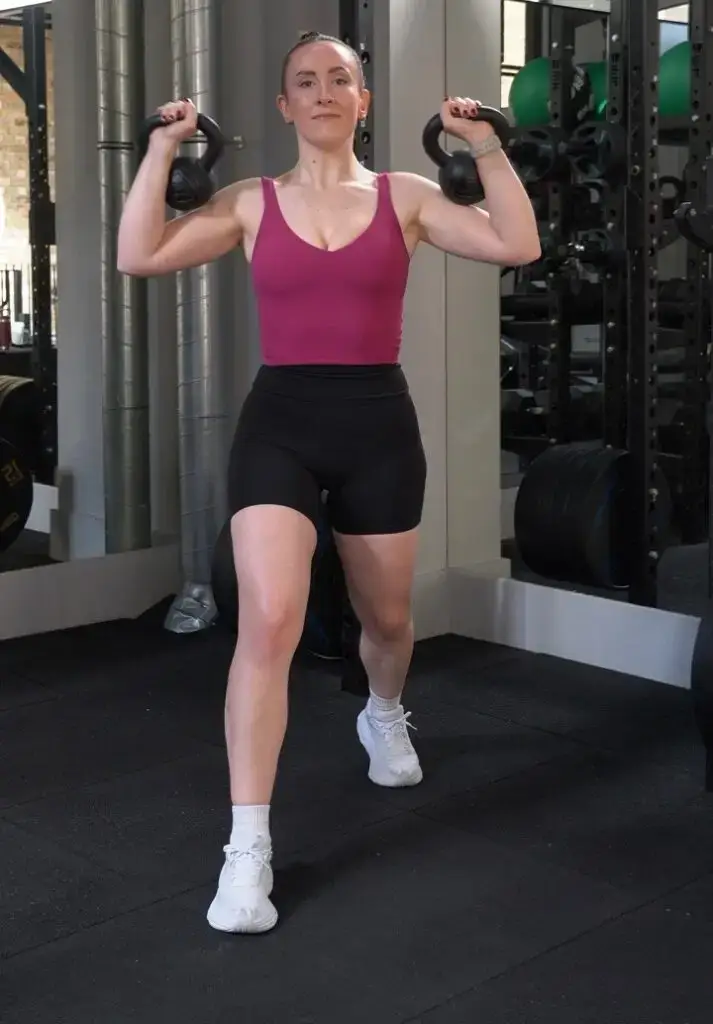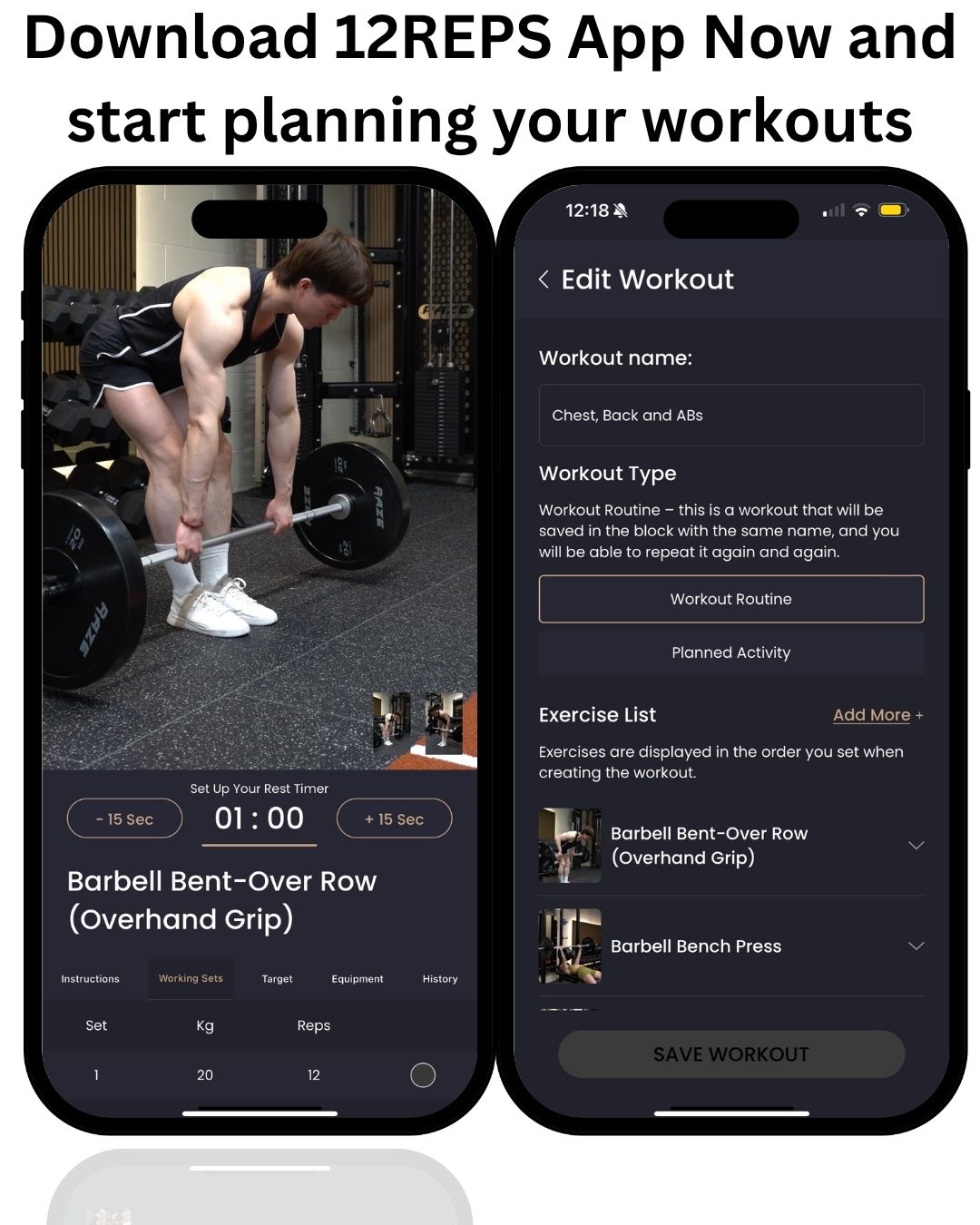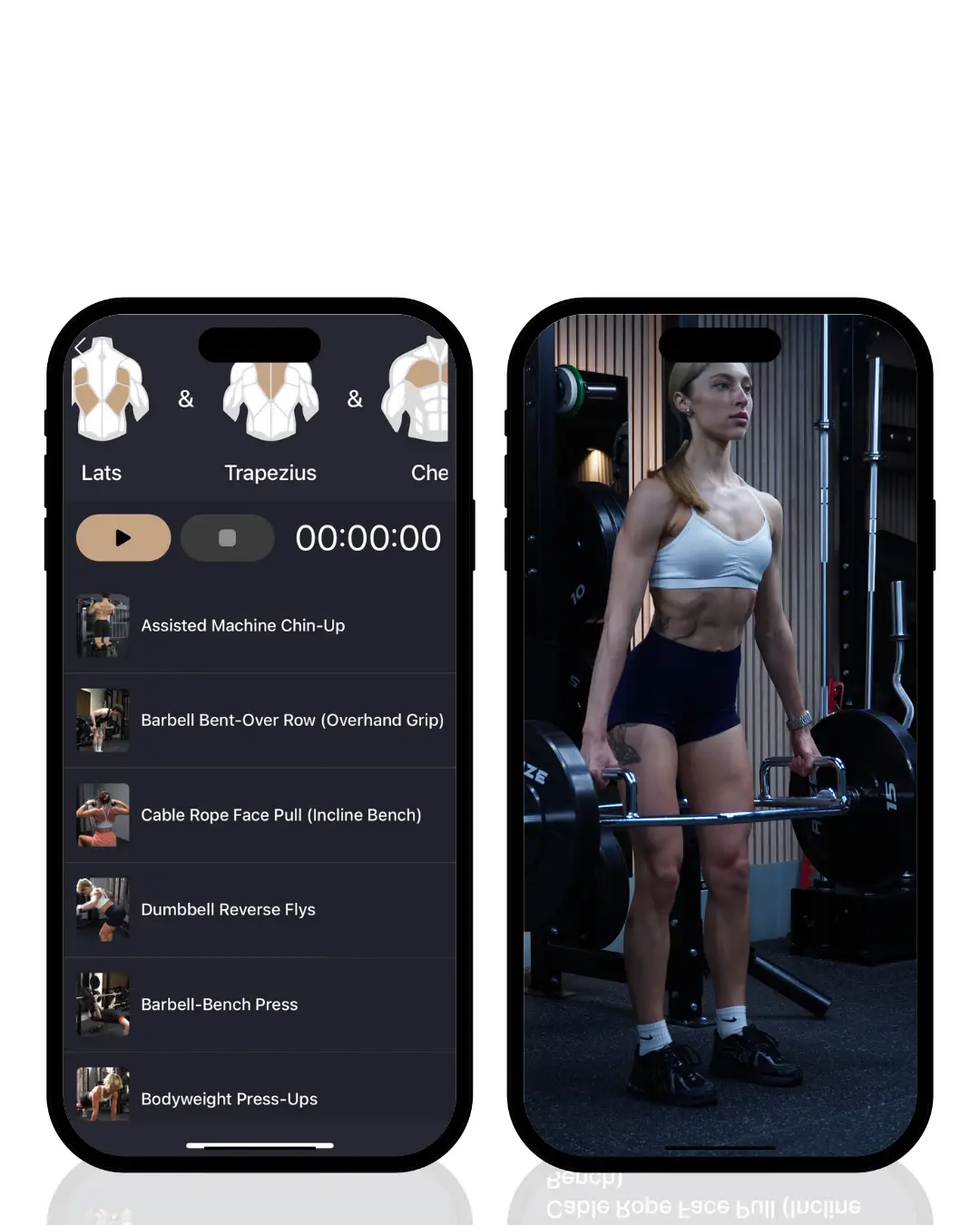Rest between sets isn’t just downtime – it’s a critical part of training that can make or break your results. In fact, the optimal rest between sets is as crucial as the exercises themselves when it comes to building muscle and strength.
Whether you’re a beginner or advanced lifter, understanding how long to rest for hypertrophy, strength, endurance, or power can dramatically improve your performance. In this article, we’ll delve into the science of rest periods and provide evidence-based recommendations tailored to each training goal.
You’ll also learn how a smart workout rest timer app (like 12reps) helps you stick to these optimal rest times for superior results. By the end, you’ll see why managing rest is key to maximising muscle growth and strength – and how 12reps makes it effortless.

The Science of Rest: Why It Matters for Your Gains
When you lift weights, your muscles rely on energy systems that need time to recover between sets. The most immediate fuel source is the ATP-PCr system (adenosine triphosphate-phosphocreatine), which powers short, intense efforts (like heavy lifts or sprints). This system gets depleted during a strict set and takes several minutes to recharge fully.
Research shows that approximately 50–70% of your phosphocreatine can be depleted in a 5–30 second burst, and it requires roughly 3–5 minutes of rest to replenish this high-powered energy completely. If you cut your rest too short, the ATP-PC system won’t recover fully, meaning your muscles may not have the quick energy needed for the next heavy set.
Another factor is lactate buildup. During moderate-to-high rep sets, your muscles produce lactate (the “burn” you feel), which causes acidity and fatigue in the muscle. Adequate rest allows your body to clear lactate and reset muscle pH levels, enabling you to perform the next set with less fatigue. This is why rest isn’t “wasted time” – it’s when your body refuels energy and removes fatigue byproducts, preparing you for the next round of effort.
Crucially, rest intervals also impact how many reps you can do and how much weight you can lift in subsequent sets. With longer rest, you’re able to maintain strength and power across multiple sets. For example, one review found that when training with heavy loads (50–90% of 1RM), using 3–5 minute rest periods allowed individuals to perform more repetitions over multiple sets.
Over time, this higher training volume and intensity lead to greater gains in strength. In contrast, very short rests can cause your performance to drop off quickly, resulting in fewer reps or reduced weight in later sets. If you’ve ever gone for a second set too soon and found you could only do half the reps, you’ve experienced this effect.
On the other hand, resting too long can also have downsides. Extremely long breaks (say 5–10+ minutes when it’s not needed) might cause you to lose focus, let your muscles cool down, and unnecessarily lengthen your workout. The key is finding the optimal rest interval for your goal: enough time to recover critical energy and strength, but not so much that you diminish the training stimulus or efficiency.
In short, the amount of rest between sets is a crucial training variable that significantly influences the efficiency, safety, and effectiveness of your workout program. Now, let’s look at what the optimal rest periods are for different goals – and why they differ.

Optimal Rest Periods for Different Training Goals
Different goals demand different rest strategies. Here’s a breakdown of rest periods for hypertrophy, strength, endurance, and power – each optimised to get the best results:
Hypertrophy (Muscle Growth): For building muscle size, a moderate rest interval is generally ideal. Approximately 60–90 seconds of rest between sets is a commonly recommended sweet spot for hypertrophy-focused training.
Resting for around a minute allows your muscles to recover, keeping them under relatively low stress, which promotes metabolic fatigue and stimulates muscle fibres – factors that can encourage growth. Shorter rest periods (under a minute) lead to higher acute growth hormone and metabolite levels during training, which was traditionally thought to boost muscle gains. However, there’s a balance to strike: if you go too short, you might not recover enough to push heavy weight on the next set.
In fact, recent evidence suggests that longer rests can also enhance hypertrophy. One study found that experienced lifters who rested for 3 minutes between sets gained more muscle size than those who rested for only 1 minute. The likely reason is that extra rest allowed them to use heavier weights or do more reps overall, increasing the training stimulus. Takeaway: Aim for approximately 1–2 minutes of rest to promote muscle growth.
This range offers a suitable balance of recovery and metabolic stress. If you’re training very hard and heavy, don’t be afraid to rest for 2-3 minutes on big lifts to maintain quality – it won’t hinder your gains, and may improve them.
Strength: When pure strength is the goal (lifting the maximum weight), longer rest periods are essential. You’ll want 2–5 minutes of rest between sets, leaning toward the higher end (3-5 min) for very heavy, near-maximal efforts. Why so long? Heavyweight lifting primarily taps into the ATP-PC energy system, which, as mentioned, requires a few minutes to fully recharge. Longer rest also lets your nervous system recover so you can recruit maximum muscle fibres again for the next set.
Studies consistently show that with about 3 minutes or more rest, lifters can preserve their strength across sets and lift heavier overall. For example, one experiment comparing 1-minute versus 3-minute rests found that the group with 3-minute rests achieved significantly higher total volume (i.e., more reps and weight lifted) than the 1-minute group.
In practice, if you’re doing low-rep heavy sets (e.g. 5 reps of squats or even singles), give yourself ample time – at least 3 minutes – to breathe, let your muscles restore ATP, and mentally prepare. This ensures you can perform at your peak in each set, which is crucial for achieving strength gains. Remember, strength training is about quality over speed; don’t rush it.
Muscular Endurance: For endurance or metabolic conditioning (high-rep or circuit-style training), rest periods are significantly shorter. Typically, 20–60 seconds of rest is sufficient (or even less, depending on the workout).
The idea here is to not fully recover, forcing your muscles to perform while somewhat fatigued, which trains them to tolerate and adapt to fatigue. Research indicates that very short rests (under a minute) can improve muscular endurance by increasing the fatigue resistance and recovery rate of the muscles over time.
Essentially, you’re keeping your heart rate up and not allowing complete recovery, mimicking the demands of endurance activities. For example, if you’re doing a high-rep circuit or bodyweight routine for endurance, you might only pause 30 seconds between exercises. This will feel challenging, but that’s the point – it conditions you to sustain performance with minimal rest. Just be mindful of form; even with short breaks, maintain good technique as you fatigue.
Power: Training for power (think explosive movements, such as Olympic lifts, jumps, or sprint-style exercises) also requires long rest periods of approximately 3–5 minutes. This is similar to strength training in that you aim for maximum intensity in each set. To move explosively – whether it’s a clean & jerk or a box jump – your muscles and nervous system must be fully refreshed.
Any fatigue can significantly reduce power output (you’ll jump lower or lift slower if you’re still tired from the last effort). Studies confirm that longer inter-set rest preserves higher power levels across multiple sets. So, if you’re doing sets of, for example, 5 jump squats or 3 power cleans, give yourself a good 3+ minutes to recover before the next round. This ensures each set is performed with maximal speed and force, which is how you effectively train the neuromuscular system for power. In short, don’t turn power training into cardio – take the full rest so each set counts.
How 12reps Ensures You Rest Optimally
Knowing the optimal rest periods is one thing – sticking to them consistently is another challenge. It’s easy to lose track of time at the gym: you might rush your rest because you’re eager to continue, or you might get distracted and rest longer than intended.
This is where the 12reps app becomes your smart training companion. The app features a built-in workout rest timer that eliminates the guesswork of rest periods, keeping you on track for optimal results.
Here’s how the 12reps rest timer works: when you finish a set, simply mark it as complete in the app – this automatically starts a countdown for your rest interval. You can set a custom rest duration for each exercise based on your goal (for example, 3:00 minutes for heavy deadlifts, 60 seconds for bicep curls, etc.).
The timer is fully adjustable, allowing you to use durations ranging from a few seconds to several minutes as needed. Once you’ve set your desired rest (say 90 seconds for a hypertrophy exercise), 12reps will count it down for you. When the time is up, you’ll start next exercise.
In short, 12reps acts like your personal coach, managing the clock so you can focus on lifting. Instead of watching the seconds or forgetting when you started resting, you can use a timer for each workout and for each individual exercise, which will keep you accountable. Additionally, your personal best with exercise is logged with the time, and each workout is tracked using a timer
In short, 12reps acts like your personal coach, managing the clock so you can focus on lifting. Instead of watching the seconds or forgetting when you started resting, you can use a timer for each workout and for each individual exercise, which will keep you accountable. Additionally, your personal best with exercise is logged with the time, and each workout is tracked using a timer.
Common Rest Period Mistakes and How to Fix Them
Even with the best intentions, many lifters fail to manage their rest periods effectively. Here are some common rest period mistakes and how to fix them:
Resting Too Little: One big mistake is rushing into your next set before you’ve recovered. If you cut your rest very short (out of impatience or the false belief that “no pain, no gain”), your muscles won’t be ready to perform. This can lead to dramatically fewer reps or a failed set, reducing your training volume and potentially increasing your risk of injury.
For example, research shows that with only 1 minute of rest, performance in the second set drops significantly compared to a properly rested 3-minute interval. Fix: Plan a minimum rest based on your goal (as outlined above) and use a timer. It might feel like you’re capable of going again sooner but give yourself that extra minute to replenish energy. You’ll likely lift more weight or complete more reps, which means more gains in the long run. Trust the process – quality beats speed in resistance training.
Resting Too Long: On the other hand, some individuals take excessively long breaks. We’ve all seen the person who does a set, then chats or scrolls on their phone for five minutes or more. Overshooting your rest time can make your workouts less efficient and may cause your muscles to cool down too much between sets. While you want complete recovery for strength sets, generally anything beyond ~5 minutes yields little added benefit for lifting performance.
For moderate hypertrophy work, routinely going beyond 2 minutes might reduce the metabolic stress that contributes to muscle growth. Fix: Use the environment or a timer to keep you accountable. If you’re doing heavy sets, try to start your next set as soon as you feel adequately recovered within that 2-5 minute window.
For moderate loads, keep it around 1-2 minutes. Using the 12reps rest timer here is a game-changer – set it, and when it buzzes, you know it’s time to get back to work. It’s fine to occasionally extend rest if you genuinely need it, but be honest: if you’re just feeling lazy or distracted, reel it in!
Not Tracking or Consistent with Rest: Many lifters don’t actually track how long they rest – they rely on their feelings. The problem is, your perception of time at the gym can be unreliable. What felt like “about a minute” might actually be 20 seconds (if you’re eager), or conversely, it could be 3 minutes (if you got lost in thought or conversation).
Inconsistent rest makes it hard to gauge your true progress and can lead to unpredictable performance. Fix: Make rest a measurable part of your routine. You don’t have to be militant with a stopwatch at all times, but having a method is essential. Use the countdown on your phone, watch the clock on the wall, or, best of all, let an app like 12reps handle it.
By standardising your rest periods, you remove a variable – so if one week you lifted more reps, you’ll know it’s because you got stronger, not because you simply rested longer. Consistency in rest will improve the quality of your training sessions.
And if you’re not already, start logging your workouts (including noting rest if relevant). Tracking builds awareness; you might be surprised to find patterns, such as performing better on exercises where you always rest for 2 minutes or more versus those where you rush. Use that data to optimise your approach.
By avoiding these mistakes, you’ll ensure that your rest periods truly serve your goals. Keep in mind that rest is an active component of training, not a passive gap. Treat it with as much respect as you do sets, reps, and weight on the bar.

Conclusion
Precise rest management is a game-changer for maximising muscle growth, strength, and overall workout effectiveness. It’s incredible how tweaking your rest intervals – making them a little longer or shorter – can accelerate your progress.
The science is precise: use longer rests when you need full power and strength, shorter rests when you want endurance and metabolic burn, and moderate rests for muscle size (with enough recovery to push hard each set). The best part is that managing all this can be automated and straightforward with the right tool.
That’s where 12reps comes in. The 12reps app is the smart workout companion that helps you optimise every aspect of your training, including rest. It frees you from clock-watching and ensures you’re always adhering to the optimal rest between sets for your goal.
By taking the guesswork out of rest periods, 12reps lets you put 100% of your focus into executing the exercises and pushing hard on each set, knowing recovery is timed to perfection. The result? Superior performance in the gym and faster progress toward the muscle and strength gains you’re after.
Don’t leave your results to chance by winging your rest intervals. Unlock your full potential by training with purposefully timed rests. With 12reps, this level of precision becomes effortless – you’ll never have to wonder if you’ve rested too little or too long.
Every second is optimised for growth and strength. Ready to take your training to the next level? Download the 12reps app today and experience the difference that optimal rest periods can make in your workouts. Make every rep and every rest count – your gains will thank you!
References:
- de Salles BF, et al. (2009). Rest interval between sets in strength training. Sports Med, 39(9), 765-777.
- Schoenfeld BJ, et al. (2016). Longer inter-set rest periods enhance muscle strength and hypertrophy in resistance-trained men. J Strength Cond Res, 30(7), 1805-1812.
- Bender B. (2019). Energy system development in the weight room: Incorporating prescribed rest periods.Strength & Conditioning Journal, 41(5), 57-61.
- Miranda H, et al. (2009). Effect of rest interval length on the volume completed during upper body resistance exercise. J Sports Sci Med, 8(3), 388-392.








